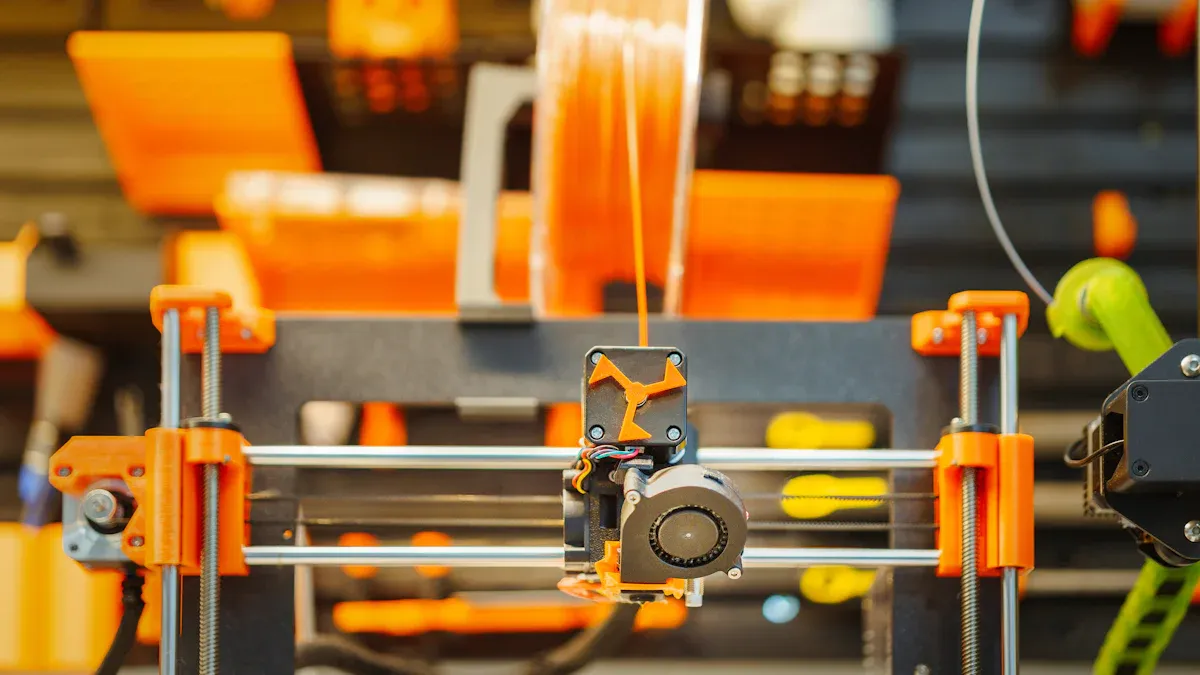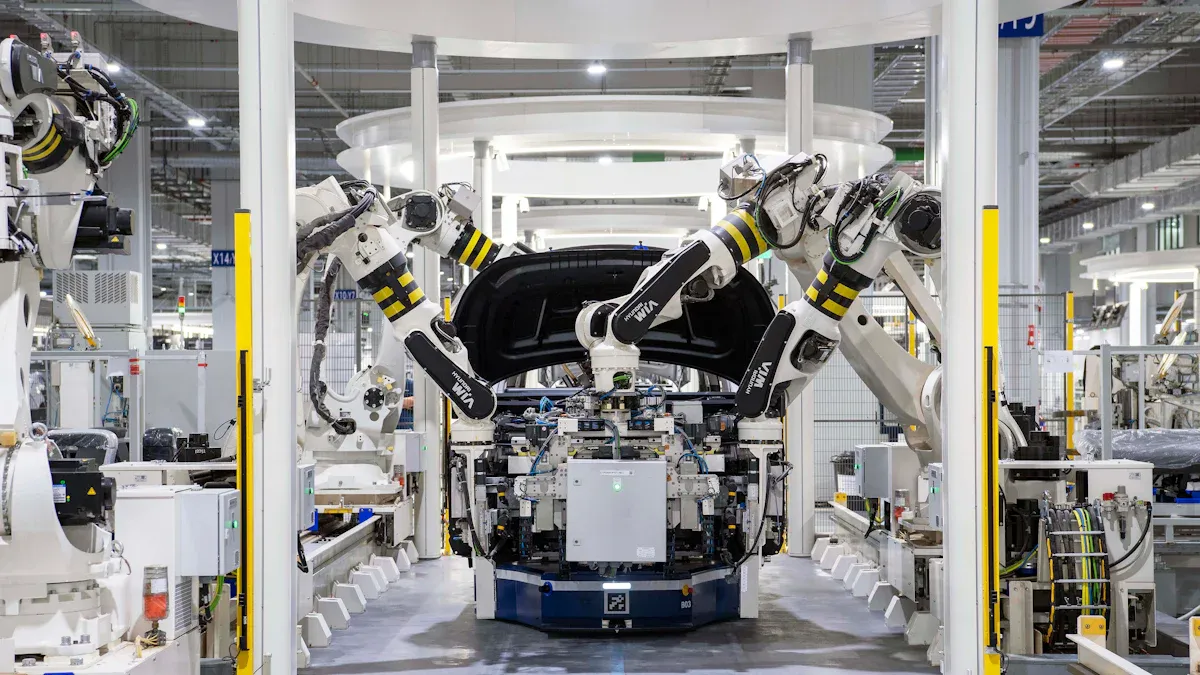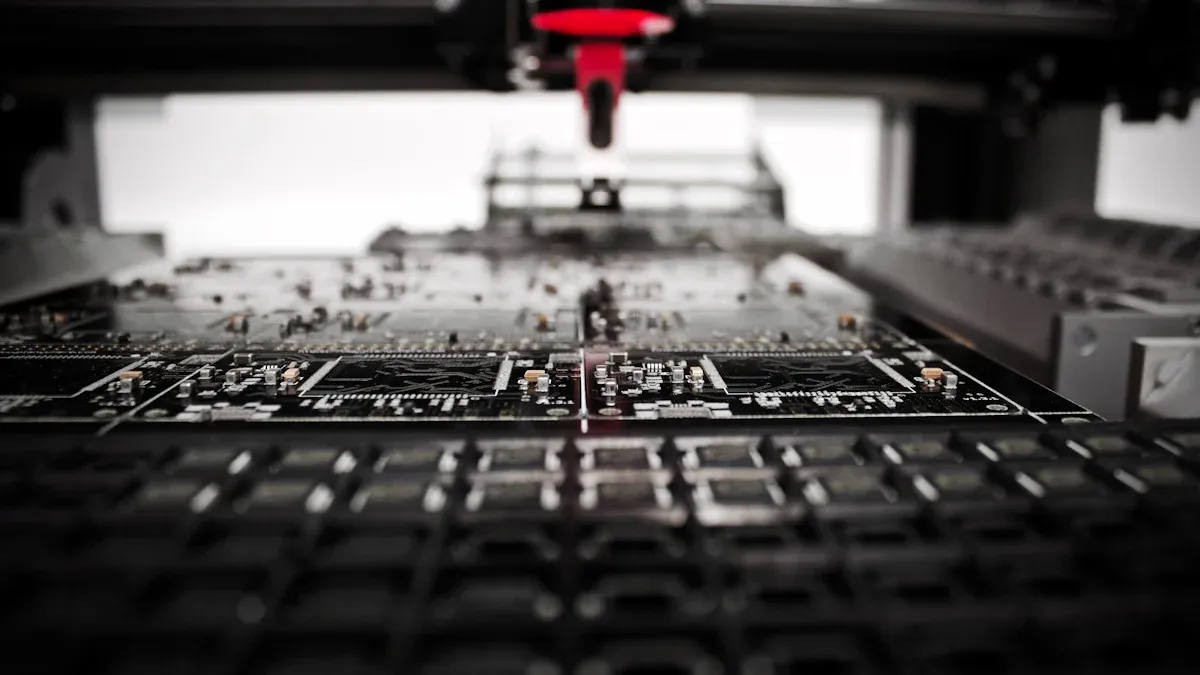A Detailed Guide to PCBA Manufacturing Processes for Beginners and Experts

Producing great electronics begins with knowing PCBA manufacturing processes well. These steps ensure each circuit board works properly, and LTPCBA leads in this area.
The company delivers over 98% of orders on time.
Careful testing and design checks ensure top quality.
Smart tools like AI and IoT improve accuracy in making boards.
This focus on quality makes LTPCBA a trusted name in PCB assembly.
Key Takeaways
Knowing about PCBA helps make dependable electronics. It means putting electronic parts on a PCB so devices work well.
Checking quality is very important in PCBA making. Tools like AOI and X-ray help find problems early and keep quality high.
Using both SMT and THT methods can improve PCB assembly. This mix uses the best of both ways for better results.
Understanding Printed Circuit Board Assembly (PCBA)

What is PCBA?
Printed Circuit Board Assembly (PCBA) means adding electronic parts to a PCB. This process turns an empty PCB into a working circuit. Steps like applying solder paste, placing parts, and soldering are involved. These steps make sure the PCB works in electronic devices.
Importance of PCBA in Modern Electronics
PCBA is very important in making modern electronics. It helps create small, powerful, and dependable gadgets. With more demand for tech like self-driving cars and IoT devices, PCBA is vital. For instance, the PCB market may grow by $26.8 billion from 2025 to 2029. This growth comes from 5G and more use of electronics. These trends show how PCBA drives new ideas and keeps us connected.
Evidence | Description |
|---|---|
Market Growth | The PCB market grows as more people use electronics. |
Key Drivers | Tech like 5G and IoT improve devices, boosting PCB needs. |
Key Components in the PCB Assembly Process
The PCB assembly process uses key tools to ensure good results. IoT tools collect live data to improve machines and save energy. Big data finds problems and helps improve production. Digital twins copy factory setups to fix issues and improve work. These tools keep the PCB assembly process smooth and effective.
IoT-enabled Production Equipment: Tracks machines and product quality live.
Big Data Analytics: Helps find problems and improve processes.
Digital Twin Technology: Copies workflows to fix issues and save time.
Overview of PCBA Manufacturing Technologies
Printed circuit board assembly uses advanced tools for modern electronics. Each method has its own benefits and fits certain uses. Let’s look at the main technologies in pcb assembly.
Surface Mount Technology (SMT) in PCB Assembly
SMT is the most common way to assemble circuit boards. It places parts directly on the pcb surface without drilling holes. This method makes designs smaller, lighter, and more efficient.
Benefit | Description |
|---|---|
Smaller PCB Size and Weight | SMT uses tiny parts, making pcbs compact for small gadgets. |
Faster Manufacturing | Automated machines make production quicker and more cost-friendly. |
Better Electrical Performance | Shorter leads mean less signal loss, great for fast devices. |
Lower Costs | No holes needed, saving materials and labor, plus fewer errors. |
Higher Component Density | More parts fit on both sides, allowing complex, tiny designs. |
Automation helps SMT by reducing mistakes and speeding up work. For example, automated SMT lines can make 50% more products and cut costs by 30%. This makes SMT perfect for making many items like smartphones and IoT gadgets.
Through-Hole Technology (THT) and Its Applications
THT is an older method where parts go into drilled holes and are soldered. Though older, THT is still used because it’s very reliable.
THT is strong and used in aerospace, military, and electronics.
It handles heat, shaking, and stress, great for tough conditions.
Prototypes use THT since parts can be swapped easily.
High-power devices like motors use THT for big parts and heavy currents.
For example, airplanes use THT for important systems that work in extreme conditions. Military tools like radios use THT for strong soldering that lasts in rough places.
Combining SMT and THT: Hybrid Assembly Methods
Sometimes, SMT and THT are combined for hybrid assembly. This mix uses SMT for small parts and THT for strong, big parts.
Hybrid assembly is used in things like power supplies and control systems. For example, SMT builds small circuits, while THT secures big connectors. This mix ensures both efficiency and strength in pcb assembly.
Using hybrid methods helps save money and improve performance. Smart tools like machine learning also help by fixing signal issues and reducing errors.
Step-by-Step Guide to PCBA Manufacturing Processes

Solder Paste Application: The Start of PCB Assembly
The first step in PCB assembly is applying solder paste. A stencil, matching the board's design, helps apply the paste. This ensures the paste only goes where parts will be placed. This step is very important for the final product's quality.
Solder Paste Inspection (SPI) checks the paste's volume, area, and height. Too little paste can cause weak connections. Too much paste can create short circuits. SPI catches these problems early, making the process more reliable.
Tip: Use stencils and reference boards to keep things consistent. SPI feedback helps fix issues quickly, reducing mistakes.
Component Placement with Pick-and-Place Machines
After applying solder paste, components are placed on the PCB. Pick-and-place machines make this step fast and accurate. These machines use suction cups and cameras to position even tiny parts correctly.
Feature/Statistic | Description |
|---|---|
Component Size Range | Handles parts from 0.4 mm × 0.2 mm to 50 mm × 40 mm. |
Precision Placement | Uses cameras and fine adjustments for exact placement. |
Margin of Error | Placement errors are less than 0.5 mm (0.02 inches). |
Technology Used | Uses suction cups and rotating nozzles for precise handling. |
Adaptability | Works with large or oddly shaped parts for flexibility. |
Error Compensation | Fixes placement errors during pickup for better accuracy. |
These machines improve speed and reduce mistakes. Fewer mistakes mean better efficiency and higher-quality products.
Reflow Soldering: Securing Components to the PCB
Reflow soldering attaches components to the PCB by heating the solder paste. The board goes through a reflow oven with controlled heat and cooling. Good heat control ensures strong connections.
Strategy | Impact on Electrical Connection Integrity |
|---|---|
Prevents uneven heating and damage to parts. | |
Proper board design | Spreads heat evenly across the board. |
Thermal relief patterns | Protects sensitive parts from heat stress. |
Optimized reflow profile | Reduces defects like voids or weak connections. |
Temperature profiling ensures the solder bonds parts securely. Adjusting the reflow profile also prevents common defects.
Note: A good reflow profile reduces risks and makes solder joints stronger. This improves the PCB's reliability.
Inspection and Testing for Quality
Inspection finds and fixes problems before the final assembly. Automated Optical Inspection (AOI) and X-ray tools check for defects. Functional testing ensures the PCB works as expected.
AOI: Uses cameras to find missing parts or solder issues.
X-ray Inspection: Finds hidden problems like voids in solder joints.
Functional Testing: Tests the PCB under real-world conditions.
Using these methods ensures high-quality PCB assemblies.
Final Assembly and Packaging
The last step is putting the PCB into its case and packing it. Good packaging protects the board during shipping. Anti-static bags and shock-proof materials prevent damage. Fast delivery avoids delays.
Use anti-static bags to stop static damage.
Add shock-proof materials to protect the board.
Deliver on time to keep production on schedule.
Paying attention to these steps ensures customers get high-quality PCBs.
Quality Control and Industry Standards in PCB Assembly
Why Quality Control Matters in PCBA Manufacturing
Quality control is key to making reliable PCB assemblies. It helps find and fix problems early in production. A strong quality control process improves product performance and customer trust. Advanced tools like AOI and X-ray systems spot defects accurately. Functional testing checks if the final product works as it should.
Following industry standards like IPC and ISO boosts product quality. These rules ensure consistency and reliability in making PCBs. For example, IPC standards focus on better product quality. ISO certifications confirm global quality management practices.
Tip: Keep detailed records to meet rules and solve problems faster.
Inspection Tools: AOI, X-Ray, and Functional Testing
Inspection tools are important for finding defects in PCB assembly. AOI is fast and great for spotting surface problems on complex boards. But it can’t find hidden issues. X-ray inspection finds internal problems like solder voids but costs more and takes longer. Functional testing checks if the PCB works properly.
Inspection Tool | Benefits | Drawbacks |
|---|---|---|
AOI | Fast, flexible, collects quality data | Can’t find hidden solder or circuit errors |
X-Ray | Finds hidden defects and checks internal layers | Expensive, slower process |
Functional Testing | Tests electrical performance, good for large-scale production | Only checks operational performance |
Using all these tools together ensures better quality control in PCB assembly.
Following Industry Standards: IPC, ISO, and UL Rules
Following standards is important for high-quality PCB production. IPC standards like IPC-A-600 and IPC-6012 focus on reliable PCB assemblies. ISO 9001:2015 ensures your processes meet global quality rules. UL 796 certification confirms your boards are safe and meet regulations.
Standard/Certification | What It Ensures |
|---|---|
ISO 9001:2015 | Confirms quality management meets international standards. |
UL 796 | Ensures safe design and production of circuit boards. |
IPC-A-600 / IPC-6012 | Sets global quality rules for PCB assemblies. |
Following these standards shows you are committed to making safe and reliable products.
Best Practices for Successful PCB Assembly
Tips for Beginners in PCBA Manufacturing
Starting PCB assembly may seem hard at first. But, following some simple steps can help you succeed. Learn about rules like IPC-A-610 and IPC-J-STD-001. These rules make sure your soldering and checks meet quality standards.
Get basic tools like soldering irons, stencils, and magnifying glasses. These tools help you work carefully and correctly. Start with easy designs before trying harder ones. Always check your work for mistakes. Look for problems like bad soldering or misplaced parts using simple visual checks.
Tip: Keep your workspace neat and tidy. A clean area helps you avoid mistakes and work faster.
Advanced Techniques for Experts in Printed Circuit Board Assembly
Experts can use advanced methods to improve speed and quality. Automation is very helpful in modern PCB work. Fast pick-and-place machines can add thousands of parts quickly. Automated Optical Inspection (AOI) tools find mistakes fast so you can fix them right away.
Accuracy is very important in PCB assembly. Using high-tech soldering machines reduces errors and improves performance. Modern tools make every step, from applying materials to testing, easier and better.
Evidence Description | Benefit |
|---|---|
Automation ensures precise material application, reducing waste. | Saves materials and increases efficiency. |
High-speed pick-and-place machines can place thousands of components per hour. | Speeds up work and boosts production. |
AOI Systems provide immediate feedback for error correction. | Cuts downtime and improves reliability. |
Avoiding Common Mistakes in the PCB Assembly Process
Mistakes in PCB assembly can cause problems and cost more money. Common errors include bad soldering, misplaced parts, and short circuits. These happen because of uneven solder paste, poor placement, or lack of experience.
To prevent these issues, focus on better processes and training. Use solder paste inspection (SPI) tools to check paste application. Regularly adjust pick-and-place machines for accuracy. Train workers well to reduce human mistakes.
Causes | |
|---|---|
Poor soldering | Problems with soldering or uneven paste application |
Device displacement | Machines not placing parts accurately |
Short circuit | Faulty parts or PCB issues |
False soldering | Lack of training or poor process control |
Note: Fixing these problems with better methods and training lowers errors and improves quality.
Learning PCBA steps helps make electronics well and quickly. Steps like adding solder paste and reflow soldering are key. Modern methods like SMT and THT make work faster. Mixing these methods adds more options for making boards. Checking quality is very important to avoid mistakes and follow rules.
Description | |
|---|---|
Saving Money | Automation cuts costs by using less time and labor. |
Faster Work | Better processes help make more boards in less time. |
Better Accuracy | New soldering tools make fewer mistakes and fixes needed. |
Smaller Designs | New ideas help create tiny boards for small gadgets. |
Lower Costs | Smarter ways of working save money and materials. |
New Ideas | Improvements help make better and smarter electronics. |
Good quality checks make sure electronics work well and last long. Following rules keeps customers happy and reduces waste. Check out LTPCBA for smart and trusted PCB assembly services.
FAQ
How are SMT and THT different in PCB assembly?
SMT puts parts on the PCB surface, making it small and quick. THT places parts in drilled holes, making it strong for tough uses.
How can you make sure PCBA manufacturing is high quality?
Use tools like AOI, X-ray, and functional tests to check quality. Following rules like IPC and ISO ensures reliable and safe results.
Why is checking solder paste (SPI) so important?
SPI checks if the right amount of solder paste is used. It stops weak links and short circuits, making your PCB assembly more dependable.
See Also
Understanding PCBA: Key Components and Their Functions
Essential Materials Required for Producing PCBA Effectively
Expert Strategies for Successful BGA Assembly Techniques
